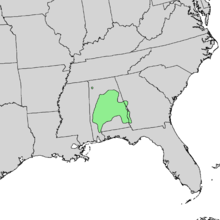Aesculus parviflora
| Bottlebrush buckeye | |
|---|---|
 |
|
| Scientific classification | |
| Kingdom: | Plantae |
| (unranked): | Angiosperms |
| (unranked): | Eudicots |
| (unranked): | Rosids |
| Order: | Sapindales |
| Family: | Sapindaceae |
| Genus: | Aesculus |
| Species: | A. parviflora |
| Binomial name | |
|
Aesculus parviflora Walt. 1788 |
|
 |
|
| Natural range | |
| Synonyms | |
|
Synonymy
|
|
Aesculus parviflora (bottlebrush buckeye) is a species of buckeye. It is also called "dwarf horse chestnut" in recognition of its resemblance to its more famous relative horsechestnut. The species is native to open woodlands of the southeastern United States (primarily Alabama with additional populations in Georgia and Alabama). It is apparently naturalized in scattered locations in North Carolina, New York, Pennsylvania, and New Jersey.
Aesculus parviflora is a deciduous suckering shrub growing to 3-5 m tall. The leaves are arranged in opposite pairs, palmately compound with 5-7 leaflets, each leaflet short-stalked, 12-22 cm long and 5-10 cm broad, with an entire margin. The flowers are produced in conspicuous erect panicles 20-30 cm long resembling a traditional bottle brush, each flower with a tubular calyx, small white petals, and several protruding 3-4 cm long stamens.
The Latin specific epithet parviflora means "small-flowered".
Aesculus parviflora is grown as an ornamental plant in gardens, where its August flowering attracts butterflies. The naturalist, explorer and plant collector William Bartram first noted this undescribed shrub on his travels through Carolina, Georgia and Florida in 1773-78. Though an old example was still to be found in Bartram's Garden, Philadelphia, in 1930, the shrub has never become common in Eastern American gardens.
...
Wikipedia
